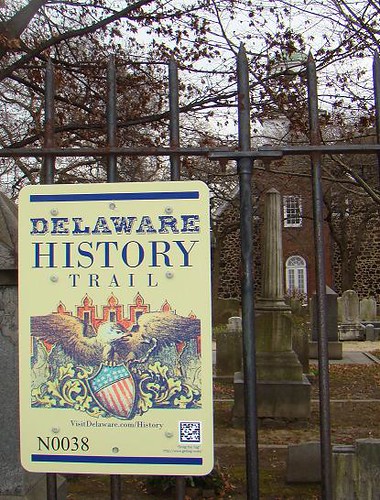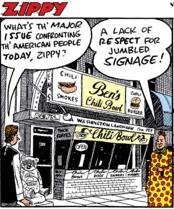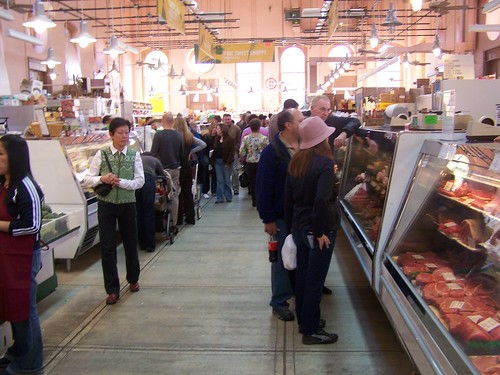May is (2018) Historic Preservation Month: 60 ways to celebrate | Part 2: Explore your community (17-33)
This post is updated and expanded annually, to encourage us to acknowledge and celebrate historic preservation, ideally not only during Preservation Month but throughout the year, by pointing out things that we can see and do.
In the past I've run this as one very long post, which grows each year as I add items. This year I've broken up the post into four, with each installment running on succeeding Mondays throughout May.
-- May is Historic Preservation Month: 60 ways to celebrate | Part 1: Learn; Get Involved (1-16)
-- May is Historic Preservation Month: 60 ways to celebrate | Part 2: Explore your community (17-33)
-- May is Historic Preservation Month: 60 ways to celebrate | Part 3: Preservation At Home (34-41)
-- May is Historic Preservation Month: 60 ways to celebrate | Part 4: Cultural Heritage Tourism (42-60)
=====
Explore Your Community from the standpoint of Historic Preservation
17. Explore an older area of your community that you don't know. Go on a neighborhood or building tour. Check out a talk (not all of them cost money) at the National Building Museum.
Or just walk around a neighborhood with housing built before 1930. Walking here and there around the core of Takoma Park, Maryland, we always come across attractive and unique houses.
18. Many preservation groups sponsor neighborhood house tours. On the first Sunday of May, Historic Takoma Park (DC and Maryland) has their annual house tour.
Similarly, every Mother's Day weekend, DC's Capitol Hill Preservation Society they have their house tour (that's this coming weekend).
There are others throughout the year in neighborhoods across your city and region.
On Saturday May 19th, the Frank Lloyd Wright Preservation Trust in Oak Park, Illinois, holds its annual House Walk tour/fundraiser.
A growing number of communities have similar kinds of interpretation programs.
Richmond's Liberty Trail links historic neighborhoods, sites, and attractions. They got the idea from Boston's Freedom Trail, which more specifically focuses on sites and places significant to the American Revolution. But Richmond's Slave Trail, interpreting the city's history in terms of slavery, started out pretty uniquely as one of the first "trail" initiatives to take on such a troubling subject.

Delaware has a state-wide history trail. The States of Maryland, Virginia, Pennsylvania, and Tennessee have a coordinated set of trails on Civil War history.
And many states and heritage areas are creating culturally-focused programs such as a whiskey trail in Kentucky, a blues trail in the Mississippi River Delta, food artisan trails, etc.
 21. Eat in a restaurant in a historic building/historic district. It's not that old, only 57 years, but Ben's Chili Bowl is one of the few remaining restaurants in the city that is truly old... Readers have suggested Martin's Tavern in Georgetown and Cafe Mozart, a German restaurant downtown.
21. Eat in a restaurant in a historic building/historic district. It's not that old, only 57 years, but Ben's Chili Bowl is one of the few remaining restaurants in the city that is truly old... Readers have suggested Martin's Tavern in Georgetown and Cafe Mozart, a German restaurant downtown.Interestingly, the Larimer Square commercial district in Denver assesses a 1% sales tax surcharge, called a Historic Preservation and Restoration Fee, to fund physical improvements in that district. It's a special purpose district that is a variant of what the State of Colorado calls "Metropolitan Districts."
A few years ago, we had a blast seeing a midnite film at the Byrd Theatre in the Carytown district in Richmond. Recently, the Byrd underwent a much overdue renovation ("Byrd Theatre in Carytown to raise ticket prices, install new seats," Richmond Times-Dispatch).
And I loved how the then barely active Lincoln Theatre in DC showed "The Girl with the Dragon Tattoo" in December 2011. It helped to reposition the theatre as an actively programmed cultural asset.
-- League of Historic American Theatres
23. See a production in a "legitimate" historic theatre or concert hall. You have many choices in the DC area such as the Warner, the National, the Studio Theatre, the Lincoln Theatre, the Shakespeare Theatre at the Landsburgh, the Atlas Performing Arts Center (which utilized federal historic preservation tax credits to pay for a portion of the building's rehabilitation), or the DAR Concert Hall.
Lido Theater, Palm Desert, California.
Note that the Pittsburgh Cultural Trust and the Cleveland Theater District Development Corporation programs to revitalize their respective interest areas through rehabilitation and operation of historic theatre buildings has been vital and central to revitalization efforts in those communities. See "Playhouse Square stars in its own real estate revival" from the Cleveland Plain Dealer.
Fisher Theatre in 1970, a few years after I first attended a children's theater production there.
Of course, there are hundreds and hundreds of such arts-based revitalization efforts, mostly on a much smaller scale, across the country.
Without realizing it, attending plays and concerts as children can be the first formal introduction a child has to historic preservation.
One of my first such experiences was as a child seeing a play in the historic Fisher Theatre in Detroit's Fisher Building.
24. Even if you're an atheist, it can be fun to visit a historic church building, including checking out their stained glass windows (I am a big fan of stained glass).
The Fifth Avenue Presbyterian Church in Manhattan/New York City often has its doors open when the choir is practicing. Many churches offer tours or special concerts.
If you want to learn more about church architecture, a good place to start is with the book, THE CHURCH BUILDING AS A SACRED PLACE: Beauty, Transcendence, and the Eternal.(Review of the book from the Imaginative Conservative blog.)
25. Shop at a historic public food market. Eastern Market is DC's last remaining public food market building, built in 1873. (Union Market is privately owned, and was constructed in the 1970s.)
There are many great markets around the country, including the Eastern Market food district in Detroit, the Italian Market and the Reading Terminal Market in Philadelphia, the Farmers Market and Grand Central Farmers Market in Los Angeles, Pike Place Market in Seattle, the Indianapolis City Market, Lancaster Central Market in Lancaster, PA, the York Public Market in York, PA, West Side Market in Cleveland, etc.

Eastern Market in Washington DC
26. Visit a historic cemetery. In DC, we have the Congressional Cemetery or the Rock Creek Church Cemetery at St. Paul's Episcopal Church, among others. Brooklyn's Greenwood Cemetery is a standout. Some cemeteries offer tours.
27. Check out an exhibit at a local history museum or historic site, such as at the Anacostia Community Museum or the Historical Society of Washington or one of the other house museums and historic sites in the city and region.
The Pittsburgh History Center, the New-York Historical Society, Museum of the City of New York, the Jamestown Experience, the Brooklyn Historical Society, the Valentine History Center in Richmond, among others, are great local museums that are definitely worth a visit.
28. Walk the historic grounds of a local college or university. In DC, Catholic University, Trinity, Georgetown, Howard, and Gallaudet have beautiful grounds and buildings. Kendall Green at Gallaudet was designed by Frederick Law Olmsted.
Note that I wish colleges would focus on this more than they sometimes do. Howard University in DC has a beautiful campus, but you'd never know as it is tucked behind Georgia Avenue with few attempts to draw people inward to the campus. (Recently, the National Trust has set up an initiative with Howard to assist them in preservation and rehabilitation of their historic properties.)
29. Check out a monument or memorial in your community and learn more about it. We can't preserve what we don't understand or appreciate.
Over the past couple years, greater attention has been paid to monuments in honor of people associated with the Confederate cause with a demand that a more nuanced interpretation be provided, or that monuments be removed from prominent public locations ("What to do with Confederate monuments," Chicago Tribune).

Terminal Town is a fascinating book discusses in brief all of Chicago's transportation terminals--including bus stations, interurban stations, and airports.
30. Visit a local railroad or bus station, such as DC's Union Station. Designed by Daniel Burnham, it's an incredible example of the City Beautiful architectural movement. Check out chapters from Bill Wright's dissertation on Union Station. He's a great writer!
(Railroad stations tend to be grand while older bus stations tend to be gnarly, which is an interesting commentary on the place of these respective modes in transportation history and practice.)
31. Check out a historic library building. Many cities have great library buildings that now qualify as historic. A number of DC's libraries were built with support from the Carnegie Foundation (Northeast, Southeast, the old Carnegie Library downtown, Takoma, and Mount Pleasant, which is particularly gorgeous) as were more than 2,000 other libraries elsewhere in the US.
32. Take a boat trip on a local river. The pontoon boat tours of the Anacostia River leaving from the Bladensburg Waterfront Park (in Prince George's County) dip into DC. Many cities have water-based tours or smaller scale water taxi systems as well.
Boston, Seattle, New York City, and San Francisco have working passenger ferry systems. The Staten Island Ferry is working transit that's free and is a fun trip.
 33. Explore historic preservation matters in your region, beyond the borders of your community.
33. Explore historic preservation matters in your region, beyond the borders of your community.Silver Spring, Maryland is immediately north of DC and grew as an inner ring suburb. Much of its growth occurred during the "art deco" period so it has a number of buildings done in that style, including an early version of a "park and shop" strip shopping center, the Silver Theatre, and other commercial buildings.
Their historic trail marker system is excellent.
Not quite two miles from DC is the Bladensburg Waterfront Park in Bladensburg, Maryland.
Reflect about when this was a major port, when tobacco was king, and DC was still part of Prince George's County, Maryland. They offer river rides on the weekends, including a jaunt into DC to the National Arboretum. Prince George's County has an extensive inventory of historic sites that are open to the public, etc.
In Prince George's County, the Historic Hyattsville (Maryland) house tour is Sunday May 14th.
Labels: cultural heritage/tourism, cultural planning, historic preservation, land use planning, transportation history, urban design/placemaking, urban history







1 Comments:
https://www.courant.com/news/connecticut/for-hc-biz-hartford-history-bill-hosley-20190210-h5avjfoqfjgvtnmz357wezbkdy-story.html
Post a Comment
<< Home